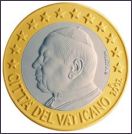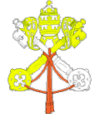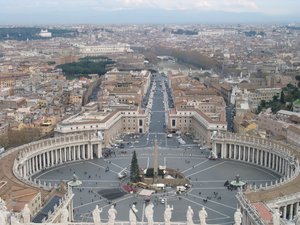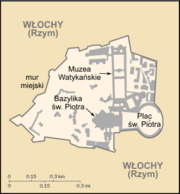Vatican City
|
|
Vatican City — formally known as the State of the Vatican City or Vatican City State is a sovereign landlocked enclave surrounded by Rome, Italy. The modern-day home of the popes, it is the smallest independent state in the world in terms of area and population. Its borders are coextensive with the Holy See, the ecclesiastical seat of the Roman Catholic Church and its Eastern Rite.
The Head of State is the Pope; the Heads of Government are the Secretary of State and Governor of Vatican City (sometimes referred to as the President of Vatican City). Currently, they are Pope Benedict XVI of Germany, Angelo Cardinal Sodano of Italy and Edmund Cardinal Szoka of the United States, respectively. The governance of the Holy See is separate, consisting of the Roman Curia in turn consisting of members of the College of Cardinals. The Heads of Government are concurrently agents of the Roman Curia.
The city takes its name from Mons Vaticanus, also known as Vatican Hill. Mons Vaticanus and the adjacent Vatican Fields upon which St. Peter's Basilica and its Sistine Chapel, Apostolic Palace and museums were built, predates Christendom.
| |||||
| National motto: None | |||||
| Missing image LocationVaticanCity.png Location of the Vatican City | |||||
| Official languages | Latin1 | ||||
| Capital | Vatican City2 | ||||
| Pope | Benedict XVI | ||||
| Secretary of State | Angelo Cardinal Sodano | ||||
| Governor of Vatican City | Edmund Cardinal Szoka | ||||
| Area - Total - % water | Ranked 261st 0.44 km² Negligible | ||||
| Population - Total (2004) - Density | Ranked 192nd 921 2093/km² | ||||
| Independence - Date | Lateran treaties 11 February 1929 | ||||
| Currency | Euro (€) | ||||
| Time zone - in summer | CET (UTC+1) CEST (UTC+2) | ||||
| National anthem | Inno e Marcia Pontificale | ||||
| Internet TLD | .va | ||||
| Calling Code | +379 | ||||
|
1 Italian is commonly used. | |||||
| Contents |
History
Main article: History of the Vatican City
It is supposed that this originally uninhabited part of Rome (the ager vaticanus) had always been considered sacred, even before the arrival of Christianity. In 326 the first church, Constantine's basilica, was built over the supposed site of the tomb of Saint Peter, and from then on the area started to become more populated.
Popes in their secular role gradually extended their control over neighbouring regions and, through the Papal States, ruled a large portion of the Italian peninsula for more than a thousand years until the mid 19th century, when most of the territory of the Papal States was seized by the newly united Kingdom of Italy.
In 1870, the Pope's holdings were further circumscribed when Rome itself was annexed. Disputes between a series of "prisoner" popes and Italy were resolved on February 11, 1929 by three Lateran treaties, which established, under Mussolini, the independent state of the Vatican City and granted Roman Catholicism special status in Italy. In 1984, a new concordat between the Holy See and Italy modified certain provisions of the earlier treaty, including the primacy of Roman Catholicism as the Italian state religion.
Government
Main article: Government of the Vatican City
Vatican City is considered a non-hereditary elective monarchy with a sovereign that wields absolute authority. The monarch exercises supreme legislative, executive and judicial power not only over Vatican City but also over the coextensive Holy See. The monarch is the Pope, elected for a life term in conclave by cardinals under the age of 80.
The Pope appoints cardinals to seats in the Roman Curia with specific authority to administer Vatican City. The chief executive is the Governor of Vatican City (often called the President of Vatican City). He is given the duties normally assigned to a premier or prime minister in other countries. The chief executive of the larger Roman Catholic Church is the Secretary of State, specifically responsible for the foreign relations of Vatican City. Legislative power is given to the Pontifical Commission for Vatican City State — members are appointed by the Pope to terms of five years.
The term "Holy See" refers to the composite of the authority, jurisdiction, and sovereignty vested in the Pope and his advisors to direct the worldwide Roman Catholic Church. As the "central government" of the Roman Catholic Church, the Holy See has a legal standing that allows it to enter into treaties as the juridical equal of a state. The Pope delegates the internal administration of the Vatican City to the Pontifical Commission for the State of the Vatican City. The legal system is based on canon, or ecclesiastical, law; if canon law is not applicable, the laws of the city of Rome apply.
During a sede vacante (papal vacancy), the Chamberlain of the Holy Roman Church, former Secretary of State, and former President of the Pontifical Commission form a commission that performs some of the functions of the head of state; while another made up of the Chamberlain and three cardinals (one being chosen by lot every three days from each order of cardinals), performs other functions of the head of state. All decisions of these commissions must be approved by the College of Cardinals.
Created in 1929 to provide a territorial identity for the Holy See in Rome, the State of the Vatican City is a recognized national territory under international law. On this basis, the Holy See enters into international agreements and both receives and sends diplomatic representatives. Due to the very limited territory of the Vatican state, foreign embassies to the Holy See are located in the Italian part of Rome; Italy actually hosts its own Embassy of Italy! The Holy See is a permanent observer in the United Nations, and in July, 2004, gained all the rights of full membership except voting. According to Archbishop Celestino Migliore, Holy See Permanent Observer, "We have no vote because this is our choice." He added that the Vatican considers that its current status "is a fundamental step that does not close any path for the future. The Holy See has the requirements defined by the UN statute to be a member state and, if in the future it wished to be so, this resolution would not impede it from requesting it."
Administration of the Vatican City
The Pope delegates the internal administration of the Vatican City to the Pontifical Commission for the State of the Vatican City. The Vatican City maintains the Swiss Guards - a voluntary military force, as well as a modern security corps. It has its own post office, commissary (supermarket), bank, railway station, electricity generating plant, and publishing house. The Vatican also issues its own coins and stamps and controls its own internet domain (.va). Radio Vatican, the official radio station, is one of the most influential in Europe. L'Osservatore Romano is the semi-official newspaper, published daily in Italian, and weekly in English, Spanish, Portuguese, German, and French (plus a monthly edition in Polish). It is published by Catholic laymen but carries official information.
Administration of the Holy See
The Pope rules the Holy See through the Roman Curia and the Papal Civil Service. The Roman Curia consists of the Secretariat of State, nine Congregations, three Tribunals, 11 Pontifical Councils, and a complex of offices that administer church affairs at the highest level. The Secretariat of State, under the Cardinal Secretary of State, directs and coordinates the Curia. The current incumbent, Angelo Cardinal Sodano, is the Holy See's equivalent of a prime minister. Archbishop Giovanni Lajolo, Secretary of the Section for Relations With States of the Secretariat of State is the Vatican's foreign minister. Sodano and Lajolo served in their respective roles under Pope John Paul II and were then reappointed to those same roles by Pope Benedict XVI.
Among the most active of the major Curial institutions are the Congregation for the Doctrine of the Faith, which oversees church doctrine; the Congregation for Bishops, which coordinates the appointment of bishops worldwide; the Congregation for the Evangelization of Peoples, which oversees all missionary activities; and the Pontifical Council for Justice and Peace, which deals with international peace and social issues.
Three tribunals are responsible for judicial power. The Apostolic Penitentiary deals with matters of conscience; the Sacra Rota is responsible for appeals, including annulments of marriage; and the Apostolic Signatura is the final court of appeal.
The Prefecture for Economic Affairs coordinates the finances of the Holy See departments and supervises the administration of the Patrimony of the Holy See, an investment fund dating back to the Lateran Pacts. A committee of 15 cardinals, chaired by the Secretary of State, has final oversight authority over all financial matters of the Holy See, including those of the Institute for Works of Religion, the Vatican bank.
Photos of St. Peter's Basilica and Square
Geography
Main article: Geography of the Vatican City
The Vatican City, one of the European microstates, is situated on the Vatican Hill in the north-western part of Rome, several hundred metres west of the Tiber river, on the latter's right bank. Its borders (3.2km in total, all with Italy) closely follow the city wall constructed to protect the Pope from outside attack. The situation is more complex at the famous St. Peter's Square in front of the St. Peter's Basilica, where the correct border is the middle of the round area surrounded by Bernini's columns. It is the smallest sovereign state in the world at 0.44 km² (108.7 acres). According to the Lateran Treaties, certain properties of the Holy See, although not being part of the territory of the City State, enjoy the privilege of extraterritoriality (e.g. Major Basilicas, Curial and diocesan offices, Castel Gandolfo). The Pope is the Head of State, though he governs through the Pontifical Commission for the State of Vatican City.
Its climate is naturally the same as Rome's; a temperate, Mediterranean climate with mild, rainy winters from September to mid-May and hot, dry summers from May to September.
Economy

Main article: Economy of the Vatican City
Budget: Revenues (2003) $252 million; expenditures (2003) $264 million. Industries: printing and production of few mosaics and staff uniforms; worldwide banking and financial activities. This unique, non-commercial economy is also supported financially by contributions (known as Peter's Pence) from Roman Catholics throughout the world, the sale of postage stamps and tourist mementos, fees for admission to museums, and the sale of publications. The incomes and living standards of lay workers are comparable to, or somewhat better than, those of counterparts who work in the city of Rome.
Vatican City has used the Euro as its currency since January 1, 2002.
Demographics
Main article: Demographics of the Vatican City
Vat_swissGuard.jpg
Almost all of Vatican City's 921 citizens live inside the Vatican's walls. The Vatican citizenry consists mainly of clergy, including high dignitaries, priests, nuns, as well as the famous Swiss Guard, a volunteer military force. There are also about 3,000 lay workers who comprise the majority of the Vatican work force, but who reside outside the Vatican.
The official language is Latin, the otherwise extinct language that originated in Rome and has remained in use in the Roman Catholic Church. Italian and, to a lesser extent, other languages are generally used for most conversations, publications, and broadcasts. German is the official language of the Swiss Guard.
A separate Vatican City citizenship exists, enabling Vatican officials to travel on Vatican passports, and giving them diplomatic status in countries to which they are accredited. At the end of 2003 552 persons held Vatican citizenship, of whom 61 were cardinals, 346 were other clergy, 101 members of the Pontifical Swiss Guard and 44 were other lay persons. Nearly all these people were dual citizens, retaining citizenship of their own countries while working at the Vatican. Most Italians employed in the Vatican do not have Vatican citizenship.
Foreign relations
Main article: Foreign relations of the Vatican City
The Holy See is the legal body that conducts diplomatic relations for the Vatican City. It maintains formal diplomatic relations with 174 sovereign states (http://www.vatican.va/news_services/press/documentazione/documents/corpo-diplomatico_index_en.html), the European Union, and the Order of Malta; 69 of these maintain permanent resident diplomatic missions accredited to the Holy See in Rome. The rest have missions with dual accreditation outside Italy, as the Holy See does not accept dual accreditation with an embassy located in Italy. It also has relations of a special nature with Russia (Mission with an Ambassador) and the Palestine Liberation Organization (Office with a Director). The Holy See maintains 179 permanent diplomatic missions abroad (106 of which are accredited to sovereign states). The diplomatic activities of the Holy See are performed by the Secretariat of State (headed by the Cardinal Secretary of State), through the Section for Relations with States.
The Holy See is especially active in international organizations. The Holy See has diplomatic relations with the European Union (EU) in Brussels, it is a permanent observer of the United Nations Organization (UN), Organization of American States (OAS) in Washington, Organization of African Unity (OAU), World Tourist Organization (WToO), World Trade Organization (WTO), World Health Organization (WHO), World Food Programme (WFP), United Nations Educational, Scientific and Cultural Organization (UNESCO), United Nations Environment Programme (UNEP), United Nations International Drug Control Programme (UNDCP), United Nations Centre for Human Settlements (UNCHS), Latin Union (LU), International Organization for Migration (IOM), International Labour Organization (ILO), International Fund for Agricultural Development (IFAD), and the United Nations Food and Agriculture Organization (FAO).
The Holy See is also an observer on an informal basis of the World Meteorological Organization in Geneva (WMO), United Nations Committee of Peaceful Use of Outer Space (UNCOPUOS), International Strategy for Disaster Reduction (ISDR), International Maritime Organization (IMO), African Asian Legal Consultative Committee (AALCC) and the International Civil Aviation Organization (ICAO).
The Holy See is a member of the Organization for the Prohibition of Chemical Weapons (OPCW), Organization for Security and Cooperation in Europe (OSCE), International Telecommunication Union (ITU), International Telecommunication Satellite Organization (ITSO), World Intellectual Property Organization (WIPO), Universal Postal Union (UPU), International Institute for the Unification of Private Law (UNIDROIT), United Nations High Commissioner for Refugees (UNHCR), United Nations Conference on Trade and Development (UNCTAD), International Grains Council (IGC), International Committee for Military Medicine (ICMM), International Atomic Energy Agency (IAEA), and the Preparatory Commission for the Comprehensive Nuclear Test Ban Treaty Organization (CTBTO). [Source: 2002 Holy See official website]
In 1971, the Holy See announced the decision to adhere to the nuclear Non-Proliferation Treaty in order to "give its moral support to the principles that form the base of the treaty itself." The Holy See is also a participating state in the Organization for Security and Cooperation in Europe: it is a guest of honour to the Parliamentary Assembly of the Organization for Security and Cooperation in Europe.
Furthermore, the Holy See has a delegate to the Arab League in Cairo (AL).
Culture
Main article: Culture of the Vatican City
The Vatican City is itself of great cultural significance. Buildings such as St. Peter's Basilica and the Sistine Chapel are home to some of the most beautiful art in the world, which includes works by artists such as Botticelli, Bernini and Michelangelo. The Vatican Library and the collections of the Vatican Museums are of the highest historical, scientific and cultural importance.
The permanent population of the Vatican City is predominately male, although two orders of nuns live in the Vatican. A minority are senior Catholic clergy; the remainder are members of religious orders. Many workers in the Vatican City live outside its walls, including the Swiss Guard and embassy personnel.
Men, and especially women, must adhere to strict dress codes.
Citizenship can be achieved by stable residence and by holding an office or job within the city. Tourism is an important factor in the daily life of the Vatican. The Pope leads weekly mass and other services, and appears on religious holidays such as Easter.
Transport and communications
St_peters_vat_distance.jpg
The Vatican City has no airports. There is one heliport and a 852 m standard gauge (1435 mm) railway that connects to Italy's network at Rome's Saint Peter's station. The railway is used only to transport freight.
A newspaper, L'Osservatore Romano, publishes daily in Italian, weekly in English, Spanish, French, German, Portuguese, and monthly in Polish.
The City is served by an independent, modern telephone system and post office. A bit of conventional wisdom in Rome is that international mail dropped in a mailbox in the Vatican will reach its destination more quickly than one dropped only a few hundred meters away in an Italian mailbox. The Vatican (which has its own country code, .va) has an official website, radio station, and satellite TV channels.
Miscellaneous topics
- Military of the Vatican City
- Foreign relations of the Vatican City
- Prisoner in the Vatican
- Music of the Vatican City
External links
- The Vatican official website (http://www.vatican.va/) -
- stpetersbasilica.org (http://www.stpetersbasilica.org) Largest online source for St. Peter's in the Vatican
- Some photos (http://www.gratisweb.com/fotogian/vaticano.html) - Text is in Italian
- Map of Vatican City (http://www.hot-maps.de/europe/italy/vatican/homeen.html)
- What does the word VATICAN mean? (http://www.biblelight.net/vatican.htm)
| Countries in Europe |
|---|
| Albania | Andorra | Austria | Azerbaijan1 | Belarus | Belgium | Bosnia and Herzegovina | Bulgaria | Croatia | Cyprus2 | Czech Republic | Denmark | Estonia | Finland | France | Germany | Greece | Hungary | Iceland | Ireland | Italy | Latvia | Liechtenstein | Lithuania | Luxembourg | Macedonia | Malta | Moldova | Monaco | Netherlands | Norway | Poland | Portugal | Romania | Russia1 | San Marino | Serbia and Montenegro | Slovakia | Slovenia | Spain | Sweden | Switzerland | Turkey1 | Ukraine | United Kingdom | Vatican City |
| Dependencies: Akrotiri and Dhekelia2 | Faroe Islands | Gibraltar | Guernsey | Jan Mayen | Jersey | Isle of Man | Svalbard |
| 1. Country partly in Asia. 2. Usually assigned to Asia geographically, but often considered European for cultural and historical reasons. |



